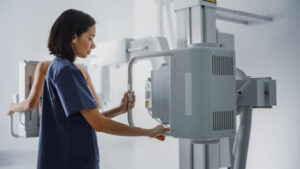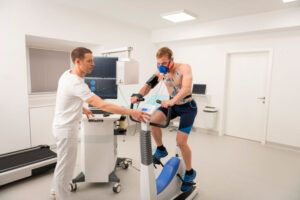Lung Cancer Diagnosis
Confirming a lung cancer diagnosis is key — once you’re diagnosed, you can start treatments to help you live longer and ease painful symptoms. Doctors typically diagnose lung cancer by looking at a patient’s symptoms, then taking imaging scans of the lungs, and finally extracting a biopsy (tissue/fluid sample). Learn about the steps to diagnose lung cancer below.
How Is Lung Cancer Diagnosed?
Lung cancer diagnosis is the process of identifying whether you have lung cancer based on your symptoms.
 If you might have lung cancer, your doctors will first take note of your health history, including what symptoms you have, if you smoked, and if you were ever exposed to other possible causes of lung cancer (like asbestos and radon).
If you might have lung cancer, your doctors will first take note of your health history, including what symptoms you have, if you smoked, and if you were ever exposed to other possible causes of lung cancer (like asbestos and radon).
From there, doctors will order imaging scans to look inside your lungs for possible signs of lung cancer (such as fluid buildup or tumors).
If lung cancer is still suspected at this stage, doctors will order a biopsy. Through a biopsy, doctors will remove a sample of possibly cancerous tissue or fluid and look at it under a microscope. If cancer cells are seen, the diagnosis can be confirmed.
- Computed tomography (CT) scans
- Positron emission tomography (PET) scans
- Magnetic resonance imaging (MRI) scans
- X-rays
Getting a lung cancer diagnosis can be a very trying time for you and your family. But, there are resources available to help you afford medical care.
Get our Free Lung Cancer Guide to learn more about how lung cancer is diagnosed and how to access treatments and compensation.

- Understand risk factors
- Find top treatments
- Pursue compensation




What Types of Lung Cancer Can You Be Diagnosed With?
There are two main types of lung cancer and several subtypes you can be diagnosed with.
Non-Small Cell Lung Cancer Diagnosis
Up to 85% of lung cancer patients are diagnosed with non-small cell lung cancer (NSCLC), according to the American Cancer Society (ACS). This type of lung cancer tends to grow and spread to other parts of the body less quickly than other types.
Doctors can also diagnose cases of NSCLC as one of three subtypes.
The subtypes of NSCLC include:
- Adenocarcinoma: This is usually found in the glands of the outer part of the lung. 40% of NSCLC patients are diagnosed with this type, as noted by the American Society of Clinical Oncology (ASCO).
- Large cell carcinoma: This subtype can form in any part of the lung and usually grows and spreads faster than the other subtypes. It’s also the least commonly diagnosed NSCLC subtype.
- Squamous cell carcinoma: This is usually found in the middle of the lung next to a bronchus (air tube). Roughly 30% of NSCLC patients are diagnosed with squamous cell carcinoma, according to ASCO.
Small Cell Lung Cancer Diagnosis
Small cell lung cancer (SCLC) is less commonly diagnosed than NSCLC. Only 10%-15% of lung cancer patients will be diagnosed with SCLC, as noted by the ACS. This type usually affects people with a long history of smoking tobacco and is very aggressive.
There are two types of small cell lung cancer:
- Small cell carcinoma: This is the most commonly diagnosed type of small cell lung cancer. When viewed under a microscope during a diagnosis, these cells are flat and look similar to oats, according to the National Foundation for Cancer Research.
- Combined small cell carcinoma: This type makes up between 2% and 5% of all SCLC diagnoses. It is a mix of small cell and non-small cell lung cancer cells.
The Lung Cancer Diagnosis Process & Tests
A lung cancer diagnosis typically starts with a visit to your family doctor. It’s then followed up by imaging scans and a biopsy. Learn about each step in the diagnosis process below.
Assessing Lung Cancer Symptoms and Risk Factors
At your first doctor’s appointment, your provider will do a physical exam and ask about any symptoms you’re experiencing.
- Chest pain
- Coughing that doesn’t go away or gets worse
- Coughing up blood
- Enlarged lymph nodes in the mediastinum, the area between the lungs
- Feeling fatigued all the time
- Repeated bouts of pneumonia
- Weight loss with no known cause
- Wheezing


You should also tell your doctor if you lived with loved ones that smoked or may have been exposed to other possible causes of lung cancer, like radon, asbestos, or uranium. Doing so can help doctors narrow down the diagnosis.
If lung cancer is suspected after this initial appointment, your doctor will likely order one or more imaging scans to get a better look inside your lungs.
Imaging Tests to Detect Lung Cancer Cells
Lung cancer screening or imaging tests use magnetic fields, sound waves, X-rays, and more to create pictures of your insides.
Imaging tests for detecting lung cancer include:
- Bone scans: This test uses small amounts of radioactive material to see whether possibly cancerous tumors or other signs have spread to the bones.
- PET-CT scans: PET-CT scans are more likely to show lung tumors and other abnormalities than ordinary X-rays.
- MRI scans: These tests use strong magnets and radio waves to create detailed images of soft tissues in your body. Your doctor may order an MRI scan to see if abnormalities in the lungs have spread to other parts of the body.
- X-rays: A chest X-ray is usually the first imaging test your doctor will perform. They will order more tests if they see abnormal nodules or masses in your lungs.
If your doctors believe you have lung cancer after these scans, they’ll order a biopsy to confirm the diagnosis.
Biopsies to Diagnose Lung Cancer
Biopsies are the only way to diagnose lung cancer. Doctors remove a sample of fluid or tissue and look at it under a microscope to see if cancer cells are present.
Types of biopsies for diagnosing lung cancer include:
- Bronchoscopy: Your doctor will insert a bronchoscope — a thin, flexible tube with a camera and a light — into the airways to look at your air passages and lungs.
- Fine needle aspiration (FNA) biopsy: This is also called needle biopsy. Your doctor will insert a hollow needle into your chest wall to get a small sample from a possibly cancerous tumor.
- Sputum cytology: Your doctor will take a sputum sample and see if it has cancer cells. Sputum is the mucus you cough up from your lungs.
- Thoracentesis: Your doctor can remove fluid from the area around your lung to identify cancer cells.
- Video-assisted thoracoscopy: Your doctor will use a thoracoscope, a thin tube with a camera at the end, to see if cancer has migrated to the spaces between the chest wall and the lungs.
Were you or a loved one recently diagnosed with lung cancer? Get our Free Lung Cancer Guide for help navigating next steps.




- Understand risk factors
- Find top treatments
- Pursue compensation




Tests to Detect Spreading of Lung Cancer Cells
If your doctor finds lung cancer in your body, they might perform additional tests to see if the cancer has spread to the lymph nodes between your lungs and other nearby areas.
Tests for detecting the spread of lung cancer include:
- Endoscopic esophageal ultrasound: This type of ultrasound examines the lymph nodes near the esophagus to detect cancer and cancer spread. Your doctor may take biopsies of abnormal lymph nodes during this procedure.
- Mediastinoscopy: A mediastinoscopy uses a lighted tube inserted in front of the windpipe and behind the breastbone to take tissue samples and look at nearby lymph nodes.
- Mediastinotomy: If your doctor can’t reach certain lymph nodes via mediastinoscopy, they may perform a mediastinotomy to remove the biopsy sample. The provider will create a slightly larger incision next to the breastbone to do a mediastinotomy.
Other Tests for Lung Cancer and Healthy Lung Function


These tests are especially vital if your doctors are considering surgical procedures since surgery may remove all or part of a lung. People with poor lung function, such as long-term smokers, may not be able to withstand such surgical procedures.
There are many types of PFTs, including:
- Exercise stress test: This looks at how exercise impacts lung function.
- Lung volume test: This test measures the amount of air you can hold in your lungs and the amount of air that is left behind after you breathe out as much as possible.
- Spirometry: This commonly used PFT measures how quickly and how much you can move air in and out of your lungs.
Doctors may also perform blood tests to get a sense of your overall health.
Call (877) 446-5767 to learn if you qualify for financial aid after a lung cancer diagnosis.
What to Do After a Lung Cancer Diagnosis
Here’s what you should do after receiving a lung cancer diagnosis:
Understand Your Lung Cancer Stage
Doctors should be able to determine your lung cancer stage shortly after confirming your diagnosis.
Lung cancer stages note how far the cancer has spread through the body. Generally speaking, most cases of lung cancer are diagnosed in the later stages, by which time the cancer is harder to treat.
Make sure your doctor tells you which stage your lung cancer is in at the time of diagnosis. By knowing this, you’ll be able to make more informed choices about the treatments you wish to undergo.
Understand Lung Cancer Prognosis
Which type of lung cancer you’re diagnosed with, as well as its stage, plays a big role in predicting your overall prognosis (health outlook). Your doctor should be able to give you a lung cancer prognosis shortly after your diagnosis is confirmed.
The prognosis for lung cancer is usually poor. The overall 5-year survival rate for lung cancer is 18.6%, which is lower than many other leading cancer types. The prognosis for late-stage lung cancer is even poorer, with the five-year survival rate being only 5%.
That said, it’s still possible to become a long-term lung cancer survivor despite these prognosis statistics.
Get a Second Opinion


Lung cancer can sometimes be misdiagnosed, so getting a second opinion can help give you peace of mind if the diagnosis comes back the same. In some cases, patients have been given a more optimistic diagnosis and prognosis thanks to lung cancer second opinions.
Explore Lung Cancer Treatment
After your diagnosis is confirmed, you can start to consider your lung cancer treatment options, such as surgery, chemotherapy, and radiation. Treatments offer your best chance of living longer after a lung cancer diagnosis.
The right lung cancer specialists will be able determine the best course of treatment based on your diagnosis.
Our team can help you afford lung cancer treatments.
Get our Free Lung Cancer Guide to explore your lung cancer treatment options after a diagnosis.




- Understand risk factors
- Find top treatments
- Pursue compensation




Reach Out to Support Groups
You may feel overwhelmed by various emotions after receiving your lung cancer diagnosis, including anger, loneliness, and shame.
To cope with your emotions, you should find a support group for lung cancer patients. Being able to speak freely with a supportive group that understands you will do wonders for your mental health.
Get Help With Lung Cancer Diagnosis and Treatment
If you suspect you have lung cancer, find medical professionals who can diagnose and provide cancer care as soon as possible. If you wait too long, your lung cancer may spread to other parts of your body, worsening your prognosis.
We at Lung Cancer Group may be able to help you get financial aid for medical expenses after a lung cancer diagnosis. Learn more by getting a free case review now.
Lung Cancer Diagnosis FAQs
How serious is a lung cancer diagnosis?
A lung cancer diagnosis is generally quite serious. If you’ve been diagnosed with lung cancer, you need to get medical treatment as soon as possible. Otherwise, the cancer could spread quickly and lead to death.
What are the different types of lung cancer you can be diagnosed with?
There are two main types of lung cancer: small-cell lung cancer and non-small cell lung cancer.
Small cell lung cancer is a rare, aggressive cancer that grows and spreads quickly. It usually affects long-term smokers. In contrast, non-small cell lung cancer is more commonly diagnosed and grows and spreads slower.
What is the difference between a lung cancer and mesothelioma diagnosis?
While lung cancer and mesothelioma can both be caused by asbestos exposure, they are actually two different forms of cancer.
Lung cancer develops inside the lung, while pleural mesothelioma develops on the lung’s outer lining (the pleura). Mesothelioma can also form in the linings of other parts of the body, such as the abdomen.
It’s much more likely that you’ll be diagnosed with lung cancer than mesothelioma, as the latter is very rare (with only about 3,000 cases diagnosed per year).
Is it possible to receive a lung cancer misdiagnosis?
Yes, lung cancer misdiagnoses are possible. According to the Moffitt Cancer Center, lung cancer can be misdiagnosed as pneumonia, asthma, or other types of cancer like lymphoma.
Thus, it’s a good idea to always get a second opinion to ensure you were properly diagnosed if lung cancer is suspected. If lung cancer is misdiagnosed, doctors won’t be able to treat it properly and you could have less time to live.
Get our Free Lung Cancer Guide now for help ensuring your diagnosis is accurate and that you get the treatments needed to live longer with this cancer.

